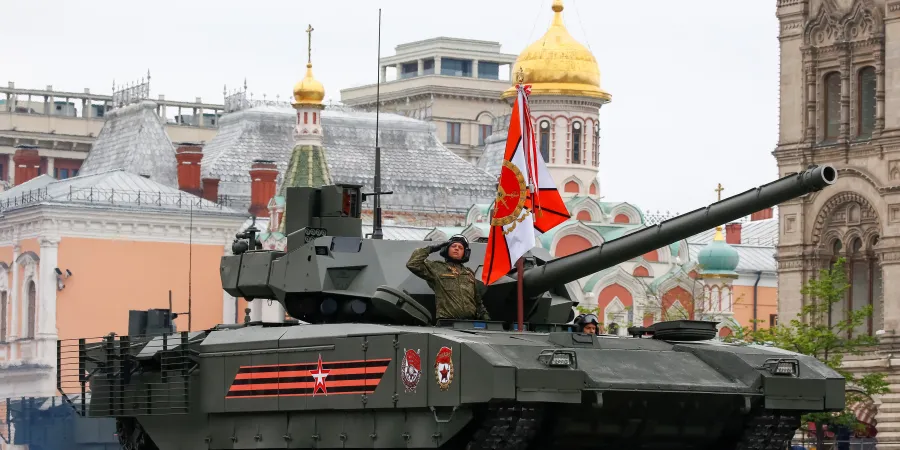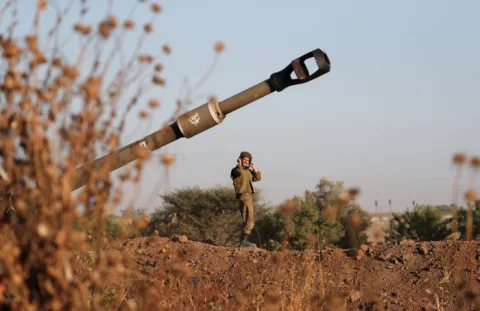Russia Tests T-14 Armata, its Most Advanced Tank, in Syria
The T-14 is one of the few 4th-generation tanks in service anywhere in the world but it is said to be a work in progress. Russia's military has also checked the capabilities of other recently-developed weapons systems, such as fighters and cruise missiles, in the Middle Eastern country
IsraelDefense
| 21/04/2020
Russia's T-14 Armata tank has undergone testing in Syria, a senior Russian official said.
In an April 19th interview, Minister of Industry and Trade Denis Manturov confirmed the tanks "were used in field conditions" in the Middle Eastern country, and that Russia "took into account all the nuances." He did not add any other details.
The testing was the latest example of Russia's military checking the capabilities of its advanced weapons systems in Syria, a war zone where foreign powers have deployed forces. It previously tested the Kh-101 and Kalibr cruise missiles, Sukhoi Su-34 fighter-bomber, Sukhoi Su-35 mulitrole fighter and the Sukhoi Su-57 stealth fighter, among others.
The T-14 is one of the few 4th-generation tanks in service anywhere in the world although it is said to be a work in progress with new armor, weapons, munitions and other technology still being developed. It was unveiled in 2015, the same year that Russia intervened in Syria's civil war.
The Armata is considered a considerable upgrade from previous Russian tanks. It has a 125mm cannon capable of firing munitions to a range of up to 7km; a dual explosive reactive armor system; an unmanned turret; next-generation fire control and data sharing systems; counter-mine defenses; high-resolution video cameras allowing 360-degree awareness; and an active defense system that uses radar for detection of anti-tank missiles, rocket-propelled grenades and other projectiles. The tank is manned by a crew of three who are protected by an internal armored capsule.
The T-14 has a top speed of 80-90 kph and a range of 500 km.
Although Moscow has touted the Armata as its tank of the future, commentators have said it is too expensive to become the main weapon of Russia's armored corps. The country reportedly intends to eventually export the tank to help subsidize production.
The T-14 is one of the few 4th-generation tanks in service anywhere in the world but it is said to be a work in progress. Russia's military has also checked the capabilities of other recently-developed weapons systems, such as fighters and cruise missiles, in the Middle Eastern country
Russia's T-14 Armata tank has undergone testing in Syria, a senior Russian official said.
In an April 19th interview, Minister of Industry and Trade Denis Manturov confirmed the tanks "were used in field conditions" in the Middle Eastern country, and that Russia "took into account all the nuances." He did not add any other details.
The testing was the latest example of Russia's military checking the capabilities of its advanced weapons systems in Syria, a war zone where foreign powers have deployed forces. It previously tested the Kh-101 and Kalibr cruise missiles, Sukhoi Su-34 fighter-bomber, Sukhoi Su-35 mulitrole fighter and the Sukhoi Su-57 stealth fighter, among others.
The T-14 is one of the few 4th-generation tanks in service anywhere in the world although it is said to be a work in progress with new armor, weapons, munitions and other technology still being developed. It was unveiled in 2015, the same year that Russia intervened in Syria's civil war.
The Armata is considered a considerable upgrade from previous Russian tanks. It has a 125mm cannon capable of firing munitions to a range of up to 7km; a dual explosive reactive armor system; an unmanned turret; next-generation fire control and data sharing systems; counter-mine defenses; high-resolution video cameras allowing 360-degree awareness; and an active defense system that uses radar for detection of anti-tank missiles, rocket-propelled grenades and other projectiles. The tank is manned by a crew of three who are protected by an internal armored capsule.
The T-14 has a top speed of 80-90 kph and a range of 500 km.
Although Moscow has touted the Armata as its tank of the future, commentators have said it is too expensive to become the main weapon of Russia's armored corps. The country reportedly intends to eventually export the tank to help subsidize production.



